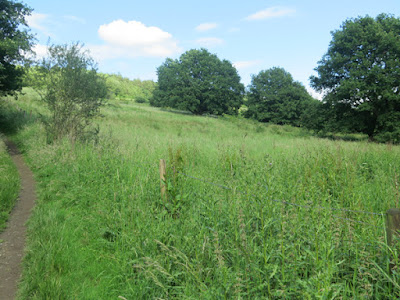 |
| Woodhouse Rock at Eckington Way roundabout |
Continuing with my exploration of the geology in the Shire Brook Valley, having unexpectedly encountered an extensive exposure of the Woodhouse Rock at Drakehouse Rocks, I arrived at the footbridge over the A57 at the Beighton roundabout.
Starting my walk back to the Shire Brook Valley Nature Reserve, I could just see outcrops of massive Woodhouse Rock behind the cover of trees on the south side of the dual carriageway but, with its borders densely planted with trees, there were very few opportunities to see it along this stretch of the A57.
On the rare occasion that I was able to get a view of the rock exposures, I could see that in places it has been reinforced with sections of masonry to provide added structural integrity, but rock netting has not been used here.
Further along the path, at one of the entrances to the former Beighton Road Landfill Site - now Linleybank Meadow - two large boulders used to prevent vehicle access caught my eye. Usually, such obstacles are large blocks of sandstone, as I had previously noted on my walks around the Waverley Estate and the Advanced Manufacturing Park.
Looking closely at these, however, the pale one is concrete and the other red/grey one, with angular fragments welded together, is possibly slag - a biproduct of the steel industry that was once a major employer in the region.
Arriving at the Eckington Way roundabout, where the roadside plantations are not so thick, I was able to get close to the road and, on its south side, a large expanse of Woodhouse Rock is clearly visible, with the bedding planes being well defined.
The apparent dip of the strata is quite obvious and, looking at the geological map of the area, it can be seen that this effectively coincides with the true dip of 8 degrees to the north-east. Although there are no footpaths on Eckington Way here, there are wide grass verges and it would be quite possible for advanced students to measure the dip and strike here.
Returning to the nature reserve, I then made my way north until I came across Shire Brook, where an area of very boggy ground adjacent to it was stained deep orange. This ochreous staining is usually associated with the oxidation of pyrite in coal seams, which I had previously seen in Ecclesall Woods, the Loxley Valley and the Porter Valley.
Walking up a moderately steep slope, I then made my way to the Birley East Colliery commemorative stone, which comprises a slab of sandstone on which an inscription and a depiction of a headstock has been cut, before continuing along Stone Lane to a path at the bottom of Sally Clark’s Meadow.
By now, I had walked 9 km without taking a break and whether it was due to tiredness on the day, or a severely reduced level of fitness due to my inactivity during the COVID-19 Pandemic restrictions, I had to stop a couple of times while walking up the steep escarpment to Woodhouse.










No comments:
Post a Comment